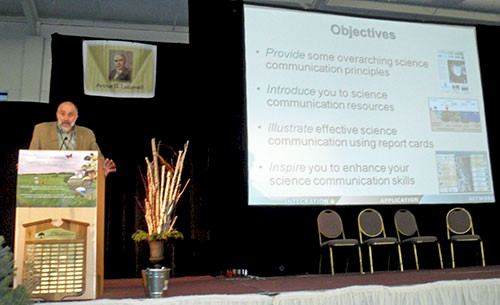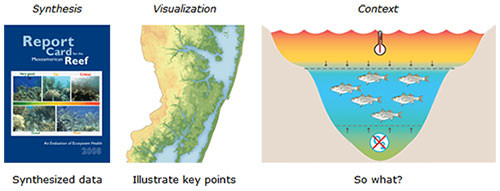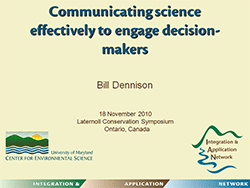Bill Dennison speech to Latornell conference, Ontario, Canada: Part 1 - Science Communication
Bill Dennison ·PART 1; Science Communication
I can't believe you are all here at 7:45 am. What's the matter with you people? This is way too early. I actually have ten years experience at the University of Queensland teaching at eight o'clock lectures, so I know how to deal with you. My jokes will fall flat, I will not get any eye contact, and what eye contact I get will be bloodshot. So, I'll just go on autopilot, because I'm going to ignore your bloodshot eyes and tell you a story about what we are doing with our Integration and Application Network. Hopefully as the caffeine kicks in, you might be able to absorb a little of this. So, first I want to point out that I'm not the first William Dennison to make his way to Toronto or the Toronto vicinity. Out of that little house in Northern Ireland that I visited about thirty years ago, my uncle Willy Dennison (us Dennison's aren't very creative about names), told me about this long lost cousin of his that ended up in Toronto. My Irish Uncle Willie was in Toronto on a business trip, and he just got the phone book out and started calling Dennisons and would say, "Are you Irish?" He finally got a "yes," and said, "Okay, are you tall?" Yes, "Do you have a big red nose?" Yes, "I think you might be related." So he showed up and went into the City Hall, and sitting there was a spitting image of a long lost relative. And so, Uncle Willie ended up with a key to the City from Mayor William Dennison. So, here I am back to Toronto, another William Dennison.

What I want to do today is provide you some overarching science communication principles to introduce you to some resources that we've been developing, to illustrate science communication using environmental report cards, because I know that in Ontario you're progressing on that front, and then also to inspire you to enhance your science communications skills. So what do I mean by "science communication"? What I mean is the successful dissemination of knowledge to a wide range of audiences, scientists and non-scientists alike. Science writing is for a peer science audience. It's about providing scientific context and lots of text, little graphics, authorship exclusive, and focused on results and interpretation. That's also your average government report. And then to science communication, that's to a much broader audience. There's the full use of colors, and lots of graphics integrated with text. And there's a focus not on results, but rather on the conclusions and recommendations.
There are some principles of good science communication that are applied to any medium that you're using, whether it is web or print media. A key is to provide synthesis, provide visualization, and provide context. With those three things, you can communicate anything to anybody. Respect your audience, relate to them, simplify the terms, but not the content. Don't dumb it down, raise the bar, and prepare for and invite questions. Don't be a geek, avoid jargon and acronym use and all the shorthand that we use within the offices that we work, but rather communicate more broadly. Also, make it look good by assembling self-contained visual elements, with consistency and style in format so that what you vary is content. The focus is on the content, not on the style. Using color can be very powerful, but you have to be careful.

Let me emphasize that I firmly believe that you can teach anything to anybody if you provide these three things. You provide the synthesis. You don't want to put raw data in front of people. You want to have visualization; they have to see it themselves. Much of the human brain is devoted to the optic processing. We are a very visual animal. Providing visuals is really key, and providing context is important. Don't throw things out that don't have any direct relevance. Make a connection to people's lives. It also requires enthusiasm, because if you're not excited about what you're talking about, neither is the audience. Quality time is needed to prepare good content, but it is a good investment. You invest in good science communication products you can use, and reuse them over and over again. Feedback and revision is essential. This is where you need to use focus groups, colleagues, surveys, and whatever you can to better your product.
Presentation Slides
The presentation slides from "Communicating science effectively to engage decision-makers" are available from IAN Press.
This is the first post in a series about Bill Dennison's keynote address at the Latornell conference in Toronto, Ontario, Canada.
Other posts in this series:
2. Part 2 - Incorporating visual elements
3. Part 3 - History of Science Communication
4. Part 4 - Environmental Report Cards
5. Part 5 - Report card examples
6. Part 6 - Five step program for environmental report cards
7. Part 7 - Oh Canada!
8. Part 8 - Communicating Science Effectively poster
About the author
Bill Dennison

Dr. Bill Dennison is a Professor of Marine Science and Vice President for Science Application at the University of Maryland Center for Environmental Science.


